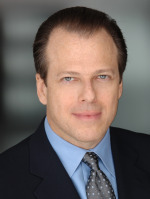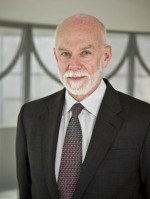Yesterday Maxwell Anderson, director of the Indianapolis Art Museum, sent me a link to an interview he did with Richard Armstrong, the new(-ish) director of the Guggenheim Museum.
 It’s quite a revelation — on the nature of Biennials, an overcultured New York, his audience and collecting plans and, most of all, about deaccessioning.
It’s quite a revelation — on the nature of Biennials, an overcultured New York, his audience and collecting plans and, most of all, about deaccessioning.
In the beginning — the video, which was posted on ArtBabble yesterday, runs for 49 minutes and 28 seconds — Max (left) simply lets Armstrong (right) talk, telling how the Guggenheim got to where it is today. But around the 40th minute, Max asks about deaccessioning. Armstrong replies:
“The collection needs to be shaped. It’s slightly misshapen….One wonders, does one need to own 114 Kandinskys, for example.”
Max, surprised, offers “we’re interested in Kandinskys,” and Armstrong plows ahead: “I just think there’s a way of deploying assets slightly differently.”
Max tries again, bringing up a conference call on deaccessioning policy among members of
 the Association of Art Museum Directors. But Armstrong counters:
the Association of Art Museum Directors. But Armstrong counters:
People have to be practical. They have to be pragmatic. They have to stop being righteous. They have to stop being proud of the fact that the museum died, but the collection is intact. That’s where we’re headed, I’m afraid, in a number of provincial places.
A lot of museums are not going to make it. There needs to be an infusion of pragmatism.
Trying to get Amstrong to draw a line somewhere, Max asks whether he’s a no-holds-barred guy on deaccessioning. Armstrong says:
I think I am, yeah.
To which, Max says, “you’ll be the cowboy on this.”
As I’ve said before, I am not an deaccessioning absolutist. It has to be done in some cases. But I wonder where Armstrong is going on this — and I hope when he and the Guggenheim board do decide to sell things that they publicize what and why is being sold and use the proceeds according to AAMD rules.
Among Armstrong’s other notable comments:
-
Biennial teamwork doesn’t work well, because curators trade off — “logroll,” as he puts it — accepting each other’s choices as compromises.
-
The Guggenheim is about to launch a Latin American initiative and it will collect art from the Middle East, becoming an international “crockpot.”
-
The Guggenheim will increase its appeal to those below 35: “the psycho-sexual center of youth is in the Lower East Side,” not near the Guggenheim, “so you have to figure out a way that it’s not a stretch for people to get up there.” (They don’t take taxis, he notes, and the Guggenheim in “not close” to the subway.) [Gee, the 86th St./Lex Station is, what, a half dozen blocks away?]
-
When he first saw the Guggenheim -Bilbao, he thought the long gallery was “hateful.” Now, as it’s filled with Serras, he likes it.
-
New York City has too many cultural organizations: “It’s overbuilt. There’s going to have to be consolidation and change, to find out what the future of high-culture can be there, what it should be, what’s affordable and sustainable. Right now, it feels like people are hiding.”
-
His duty is to rationalize Tom Krens’s decisions. There won’t be surveys covering 5,000 years (as there was with China, under Krens, for example). The Guggenheim will focus on the period from 1880 to the future; the shows will be less ambitious; and Armstrong will slow down the museum’s metabolism.
Here’s the link.
